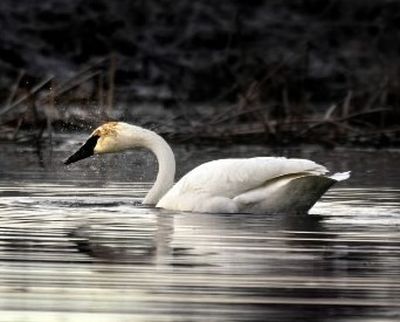For this male trumpeter swan, it’s truly a Solo act
S-R uncovers story of Turnbull Wildlife Refuge’s widower swan

Call him Solo - an elegant ambassador, and perhaps the oldest seasonal wildlife resident at Turnbull National Wildlife Refuge.
For decades, this trumpeter swan has returned every year at the refuge. He’s a family man and a widower, but as far as anyone knows, Solo has no family left.
His mate was killed, apparently by a coyote, while nesting on the refuge in 1988.
But Solo keeps coming back, mostly alone.
“He stays until freeze-up, and then we don’t know where he goes for winter,” said Mike Rule, refuge biologist. “But it’s almost as though he flies over every day during winter, because as soon as the ice melts in March, I mean like the day after it thaws, he’s back here.”
Solo is occasionally seen at Black Horse Lake, but most of his time’s spent cruising and feeding in Winslow Pond, which is just south of the refuge headquarters area, a convenient viewing spot for visitors looking for a glimpse of an endangered species.
Stick around long enough, and you’re likely to hear the trumpeter’s namesake call, which is not unlike the rasping horn of an old-fashioned French taxi.
While tundra swans commonly stop at the refuge during migrations, the larger trumpeters are rare. A family group stopped in briefly last year, Rule said.
The scene was different a few decades ago, according to refuge files.
In 1963, six trumpeter cygnets were brought to Turnbull from Red Rock Lakes National Wildlife Refuge in Montana. Another 31 cygnets were introduced from 1965 through 1966.
The first successful nesting on the refuge was in 1967, when a pair produced four cygnets. By 1970, trumpeters had eight nests on the refuge, producing 16 cygnets, 11 of which fledged.
“It was quite a trumpeter compound,” he said, noting that the refuge had installed a cyclone fence with barbed wire across the top to protect the flock.
However, the hospitality at the refuge faded in 1976.
“We used to aerate the display pond and provide supplemental feed,” Rule said. “A decision was made to stop that and go to a more natural situation, forcing the birds to migrate.
“That was a disaster for the trumpeters. The birds dispersed and mortality increased significantly. Adult birds got lost and pairs broke up and few birds returned to the refuge.”
Four adult trumpeters banded in August of 1978 were seen near Prineville, Ore., in December of that year. The last recorded citing of the young produced by those birds was two years later near Revelstoke, British Columbia.
By the mid-1980s, the fencing was gone from Winslow Pond, and Solo and his mate were the only pair returning. The one cygnet they fledged in 1984 was the last to be produced on the refuge, even though the pair tried to nest in the next four years until the female was killed.
Solo made a lame attempt to be productive again a few years ago.
“He and another swan tried to incubate a goose nest for a while, but that didn’t work, either,” Rule said. “I have a feeling he’s just too old.”
Solo was banded 23 years ago as a bird that was listed as being at least 3 years old.
“That means he’s at least 26, but there’s a possibility he’s much older,” Rule said, noting that there’s a chance that he’s one of the first cygnets produced on the refuge.
That would make him 34, about two years older than the life-span trumpeters are known to reach.
Either way, he’s one of the refuge’s most distinguished seniors - oh, the stories he could tell - and we’re fortunate that he chooses our back yard to ride out his golden years.
Trumpeter comeback: Swan lovers have something to blow their horns about this season. A midwinter count found a record number of trumpeter swans in the greater Yellowstone area, underscoring the species’ climb back from the brink of extinction.
Last year, 3,917 birds were counted in the ecosystem. This year’s count was 4,360.
Biologists attribute the population growth and expansion of territory to birds from Canada.
All Canadian trumpeters migrate south for the winter. Many fly to Yellowstone, where thermal features keep waterways free of ice and help grow food year-round.
Swan song: Two species of swans that can be found in this region used to have somewhat harmonious names. The trumpeter swan and the whistling swan.
But birders with too much free time on their hands reclassified the “whistling” swan as the “tundra” swan.
Mercy.
Such tinkering with traditional nomenclature brings us one more step away from the roots of the term “swan song.”
The term apparently was coined by hunters, who reported hearing an eerie musical call from whistling swans that had been wounded, according to the Audubon Society Encyclopedia of North American Birds.
In 1898, A biologist familiar with every note in the whistler’s repertoire, documented this entirely different“song” from a stricken bird shot by a member of his hunting party. He called it “the song of the dying swan.”
In 1955, another waterfowl specialist wrote that the “departure song” of the whistler is one of the most beautiful utterances of waterfowl: “a melodious, soft, muted series of notes that always precedes its takeoff into the air.”
He suggested, “This is probably the swan song of legend, for when a swan is shot and falls crippled to the water, it utters this call as it tries in vain to rejoin its fellows in the sky.”
Don’t freak out: Swans are hunted only on a very limited basis nowadays.
Trumpeter swans, of course, are endangered and fully protected.
Tundra swans are hunted by controlled permit in seven states, including Montana.